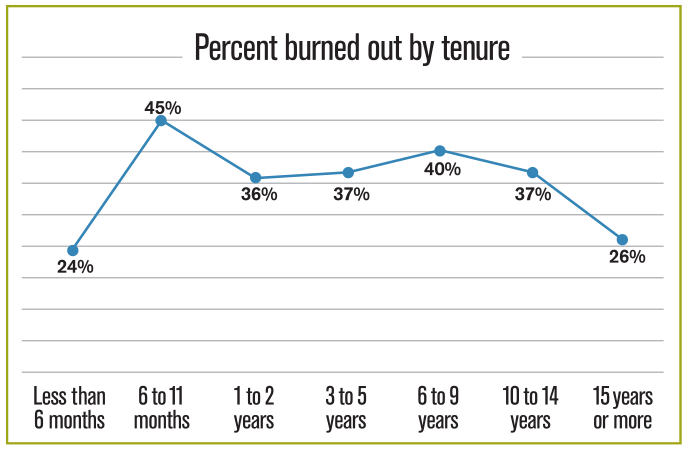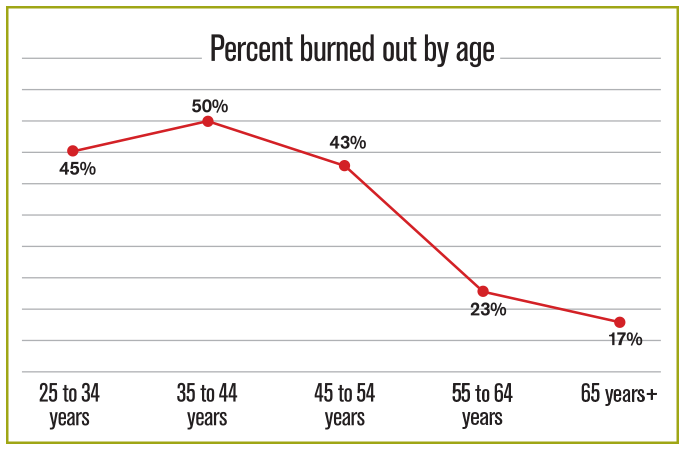The emerging connection between work and health
In the US, 34% of employees report feeling burned out from their jobs. At an organizational level, it’s important to understand the connection between work and health while having strategies in place that prioritize wellbeing.
Learn how organizations everywhere are beginning to figure out what that means.

If anything has come out of the last two years, it’s this: overall wellbeing is not a luxury or benefit – it’s a critical resource. Wellness and mental health have become a crucial priority and organizations everywhere are beginning to figure out what that means.
The impact of stress
In 2021, around 60% of all US employees reported having moderate to chronic levels of stress, which had a cascading effect on things like sleep, exercise, eating habits, blood pressure and heart disease. Stress has really begun to impact not only the way we work but also how we live our lives. Globally, the World Health Organization reports that wellness expenditures alone have topped $4.5 trillion while health expenditures have doubled at $7.8 trillion, reinforcing the escalating need for a focus on health and wellness.
In the research being conducted at the University of Louisville, there has been an emergence of data confirming there is a significant connection between how people experience their work and how they experience their health. There is a real blend that’s happening and much of that can be explained by the blurring lines between work and life. While this has been happening for the past ten years or so, what we’re looking at now is how this connection impacts the culture companies create for their employees.
Shifting culture to prioritize wellness
At an organizational level, it’s important to understand the connection between work and health while having strategies in place that prioritize wellbeing. One trend we’re seeing in how companies bring this to life is providing training around trauma informed-care. When leaders and employees alike can experience some of the situations their peers may be dealing with, it allows them to adjust their approach to one of understanding and empathy, connecting with each other in a contextually-specific way. Another area of emphasis is encouraging the creation of boundaries around social media, particularly as some or most employees are working from home.
An emphasis on wellness also includes helping employees gain access to what they need, when they need it. Wellness is really about putting a provider in front of an employee at a “just-in-time” pace. This includes things like telehealth and artificial intelligence in clinical settings, which allow providers to help employees make decisions about their own health while giving them power to dictate how their health is impacted by work and culture.
Understanding employee burnout
One area of health and wellness we’ve studied closely in our research at BIW, both pre- and post-pandemic, is employee burnout. It’s something we’ve seen increase since 2020; in the US, 34% of employees report feeling burned out from their jobs. In surveying employees, we’ve been able to identify which characteristics contribute to a higher risk of burnout, such as age, tenure, education, family composition, gender identity and more. What we’ve found is the employees most at risk for experiencing burnout have one or more of these characteristics:
• Middle-tenure level
• Aged 25-54
• Work remotely at least half of the time
• Live with children under the age of 18
• Experienced a merger in the past year
• Identify as LGBTQ+
• Report having a physical or mental disability


The increased likelihood of burnout for these employees is more about the experiences they are having at work, not necessarily how much work they are doing in a day or week. In fact, we often find very little difference in the number of hours worked per week when looking at employees who report feeling burned out versus those who do not. How much an employee works is certainly a contributing factor but it’s often not the whole story. Most of the time, employees who feel burned out at work report feeling like a hamster on a wheel, working really hard but not getting anywhere.
When surveying employees about why they feel burned out at work, the two primary reasons cited were too much work and too little work/life balance. Beyond that, other factors included:
• Lack of role clarity
• Lack of growth opportunities
• Toxic or unfair behavior or company culture
• Lack of support, recognition or rewards
• Constant change and uncertainty at work
• Lack of mental stimulation and creativity
Addressing stress and burnout
One thing that’s overwhelmingly clear in our research is authentic connection, purpose and belonging are the most effective way to manage stress and burnout. This includes being mindful of the way we work with each other as leaders and peers, particularly in a hybrid or remote environment. It’s so easy to be dismissive or to say something in a virtual meeting that we would never say or do in person. But we need to remember in a remote environment, that’s the only opportunity for connection we have.
As leaders, we also need to take concerns seriously. There are some factors we cannot control like the constant change and uncertainty. However, we can make things clear and listen to concerns. Focusing on what can be controlled, even in the absence of being able to make everything better, shows you are supportive and that you truly hear employees’ concerns. This is also where recognition can make a big difference. Recognition at its core sends a message to employees: “I see you and I value you.” It doesn’t have to be a grand gesture, but a simple acknowledgement that things are difficult and you see their efforts to persevere through it all can make a big difference in how they manage stress.
Finally, simply be aware of what contributes to burnout and show you are aware. Ask employees how they are doing in each of the areas known to cause burnout and you might uncover a problem you didn’t realize was there.
Want to know more?
Learn more about BI WORLDWIDE‘s approach to achieving employee engagement and workplace happiness













